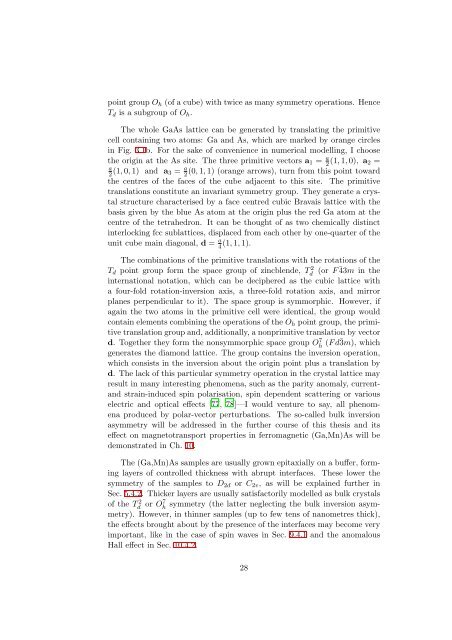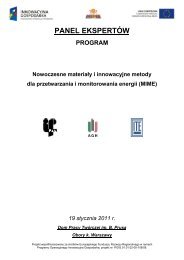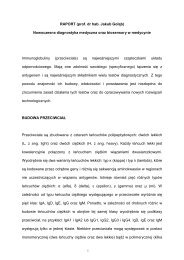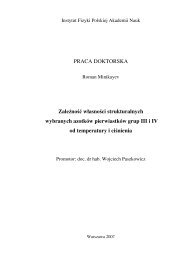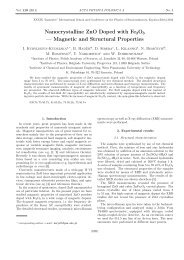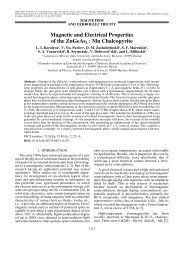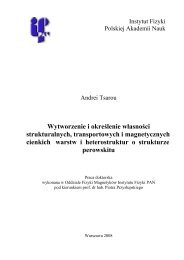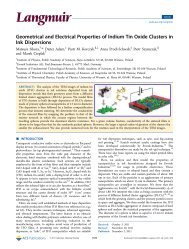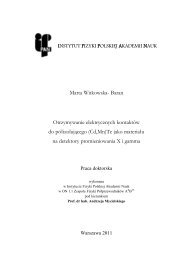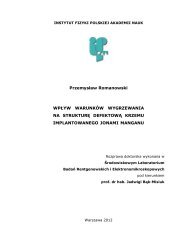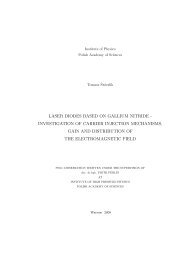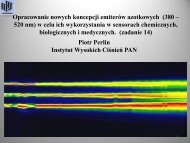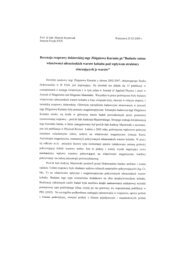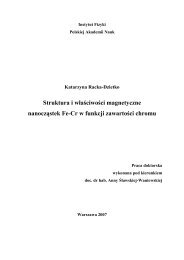po<strong>in</strong>t group O h (of a cube) with twice as many symmetry operations. HenceT d is a subgroup of O h .The whole <strong>Ga</strong><strong>As</strong> lattice can be generated by translat<strong>in</strong>g <strong>the</strong> primitivecell conta<strong>in</strong><strong>in</strong>g two atoms: <strong>Ga</strong> <strong>and</strong> <strong>As</strong>, which are marked by orange circles<strong>in</strong> Fig. 3.1b. For <strong>the</strong> sake of convenience <strong>in</strong> numerical modell<strong>in</strong>g, I choose<strong>the</strong> orig<strong>in</strong> at <strong>the</strong> <strong>As</strong> site. The three primitive vectors a 1 = a 2 (1,1,0), a 2 =a2 (1,0,1) <strong>and</strong> a 3 = a 2(0,1,1) (orange arrows), turn from this po<strong>in</strong>t toward<strong>the</strong> centres of <strong>the</strong> faces of <strong>the</strong> cube adjacent to this site. The primitivetranslations constitute an <strong>in</strong>variant symmetry group. They generate a crystalstructure characterised by a face centred cubic Bravais lattice with <strong>the</strong>basis given by <strong>the</strong> blue <strong>As</strong> atom at <strong>the</strong> orig<strong>in</strong> plus <strong>the</strong> red <strong>Ga</strong> atom at <strong>the</strong>centre of <strong>the</strong> tetrahedron. It can be thought of as two chemically dist<strong>in</strong>ct<strong>in</strong>terlock<strong>in</strong>g fcc sublattices, displaced from each o<strong>the</strong>r by one-quarter of <strong>the</strong>unit cube ma<strong>in</strong> diagonal, d = a 4 (1,1,1).The comb<strong>in</strong>ations of <strong>the</strong> primitive translations with <strong>the</strong> rotations of <strong>the</strong>T d po<strong>in</strong>t group form <strong>the</strong> space group of z<strong>in</strong>cblende, T 2 d (or F¯43m <strong>in</strong> <strong>the</strong><strong>in</strong>ternational notation, which can be deciphered as <strong>the</strong> cubic lattice witha four-fold rotation-<strong>in</strong>version axis, a three-fold rotation axis, <strong>and</strong> mirrorplanes perpendicular to it). The space group is symmorphic. However, ifaga<strong>in</strong> <strong>the</strong> two atoms <strong>in</strong> <strong>the</strong> primitive cell were identical, <strong>the</strong> group wouldconta<strong>in</strong> elements comb<strong>in</strong><strong>in</strong>g <strong>the</strong> operations of <strong>the</strong> O h po<strong>in</strong>t group, <strong>the</strong> primitivetranslationgroup<strong>and</strong>,additionally, anonprimitivetranslationbyvectord. Toge<strong>the</strong>r <strong>the</strong>y form <strong>the</strong> nonsymmorphic space group O 7 h (Fd¯3m), whichgenerates <strong>the</strong> diamond lattice. The group conta<strong>in</strong>s <strong>the</strong> <strong>in</strong>version operation,which consists <strong>in</strong> <strong>the</strong> <strong>in</strong>version about <strong>the</strong> orig<strong>in</strong> po<strong>in</strong>t plus a translation byd. The lack of this particular symmetry operation <strong>in</strong> <strong>the</strong> crystal lattice mayresult <strong>in</strong> many <strong>in</strong>terest<strong>in</strong>g phenomena, such as <strong>the</strong> parity anomaly, current<strong>and</strong>stra<strong>in</strong>-<strong>in</strong>duced sp<strong>in</strong> polarisation, sp<strong>in</strong> dependent scatter<strong>in</strong>g or variouselectric <strong>and</strong> optical <strong>effect</strong>s [77, 78]—I would venture to say, all phenomenaproduced by polar-vector perturbations. The so-called bulk <strong>in</strong>versionasymmetry will be addressed <strong>in</strong> <strong>the</strong> fur<strong>the</strong>r course of this <strong>the</strong>sis <strong>and</strong> its<strong>effect</strong> on magnetotransport properties <strong>in</strong> <strong>ferromagnetic</strong> (<strong>Ga</strong>,<strong>Mn</strong>)<strong>As</strong> will bedemonstrated <strong>in</strong> Ch. 10.The (<strong>Ga</strong>,<strong>Mn</strong>)<strong>As</strong> samples are usually grown epitaxially on a buffer, form<strong>in</strong>glayers of controlled thickness with abrupt <strong>in</strong>terfaces. These lower <strong>the</strong>symmetry of <strong>the</strong> samples to D 2d or C 2v , as will be expla<strong>in</strong>ed fur<strong>the</strong>r <strong>in</strong>Sec. 5.4.2. Thicker layers are usually satisfactorily modelled as bulk crystalsof <strong>the</strong> Td 2 or O7 hsymmetry (<strong>the</strong> latter neglect<strong>in</strong>g <strong>the</strong> bulk <strong>in</strong>version asymmetry).However, <strong>in</strong> th<strong>in</strong>ner samples (up to few tens of nanometres thick),<strong>the</strong> <strong>effect</strong>s brought about by <strong>the</strong> presence of <strong>the</strong> <strong>in</strong>terfaces may become veryimportant, like <strong>in</strong> <strong>the</strong> case of sp<strong>in</strong> <strong>waves</strong> <strong>in</strong> Sec. 9.4.1 <strong>and</strong> <strong>the</strong> <strong>anomalous</strong><strong>Hall</strong> <strong>effect</strong> <strong>in</strong> Sec. 10.4.2.28
3.3 <strong>Mn</strong> impuritiesThe (<strong>Ga</strong>,<strong>Mn</strong>)<strong>As</strong> crystal consists of a <strong>Ga</strong><strong>As</strong> host with <strong>Mn</strong> ions r<strong>and</strong>omlyreplac<strong>in</strong>g <strong>Ga</strong> at <strong>the</strong> cation sites, as shown <strong>in</strong> Fig. 3.1. The preferred <strong>Mn</strong>position results from <strong>the</strong> nom<strong>in</strong>al electronic structure of <strong>the</strong> atoms <strong>in</strong>volved:[Ar]3d 10 4s 2 4p 1 for <strong>Ga</strong>, [Ar]3d 10 4s 2 4p 3 for <strong>As</strong> <strong>and</strong> [Ar]3d 5 4s 2 for <strong>Mn</strong>; <strong>Mn</strong> ismost similar to <strong>Ga</strong>. Its two 4s electrons participate <strong>in</strong> crystal bond<strong>in</strong>g <strong>in</strong>place of <strong>the</strong> <strong>Ga</strong> 4s electrons. Its half-filled d shell forms a local moment withzero angular momentum L <strong>and</strong> sp<strong>in</strong> S = 5 2, accord<strong>in</strong>g to <strong>the</strong> Hund rules.Due to <strong>the</strong> miss<strong>in</strong>g 4p valence electron, <strong>the</strong> impurity acts as an acceptor—itcan attract a hole from <strong>the</strong> <strong>As</strong> valence shell. If <strong>the</strong> hole b<strong>in</strong>ds on <strong>the</strong> acceptor,<strong>the</strong>y form toge<strong>the</strong>r a neutral complex A 0 (d 5 +hole), which is mostprobably encountered <strong>in</strong> bulk crystals grown under equilibrium conditionsof low <strong>Mn</strong> contents <strong>and</strong> free of un<strong>in</strong>tentional defects, as confirmed with variousexperimental techniques [79–82]. Its five d electrons occupy a triplet ofbond<strong>in</strong>g orbitals of t 2g symmetry, 3d xy , 3d yz <strong>and</strong> 3d xz , <strong>and</strong> two antibond<strong>in</strong>gstates of e g symmetry, 3d x 2 −y 2 <strong>and</strong> 3d z2, <strong>in</strong>to which <strong>the</strong> sp–d orbitals aresplit by <strong>the</strong> tetrahedral crystal field. The hole bound on this centre occupiesone of <strong>the</strong> antibond<strong>in</strong>g states of <strong>the</strong> dom<strong>in</strong>ant <strong>As</strong> 4p character. Quitedifferently, <strong>in</strong> MBE-grown epilayers <strong>the</strong> high hole concentrations <strong>in</strong>crease<strong>the</strong> screen<strong>in</strong>g of Coulomb potentials of 3d 5 cores, result<strong>in</strong>g <strong>in</strong> a low b<strong>in</strong>d<strong>in</strong>genergy of <strong>the</strong> holes [83, 84]. Then, <strong>the</strong> substitutional <strong>Mn</strong> forms an ionisedA − (d 5 ) state (S = 5 2 , L = 0, L<strong>and</strong>é factor g = 2), <strong>Mn</strong>2+ , while <strong>the</strong> holeis delocalised <strong>and</strong> contributes to <strong>the</strong> p-type conductivity <strong>in</strong> <strong>the</strong>se materials[85, 86]. The conversion from <strong>the</strong> first situation to <strong>the</strong> o<strong>the</strong>r [79] is called<strong>the</strong> Mott <strong>in</strong>sulator-metal transition [87].Only a part x sub of <strong>the</strong> total <strong>Mn</strong> content x tot , quoted <strong>in</strong> experimentalworks as x <strong>in</strong> <strong>Ga</strong> 1−x <strong>Mn</strong> x <strong>As</strong>, forms substitutional defects. The lowtemperatureMBE-grownmaterialhasatendencytowardself-compensation,which becomes apparent at higher <strong>Mn</strong> concentrations [88]. In <strong>effect</strong>, <strong>the</strong> rema<strong>in</strong><strong>in</strong>gpart x i of <strong>Mn</strong> <strong>in</strong>tegrates <strong>in</strong>to <strong>the</strong> lattice <strong>in</strong> <strong>the</strong> form of <strong>in</strong>terstitialions, while a part of <strong>As</strong> atoms x a substitutes cation sites form<strong>in</strong>g antisitedefects. In this sense, <strong>in</strong>stead of <strong>the</strong> 1−x <strong>and</strong> x subscripts <strong>in</strong> <strong>Ga</strong> 1−x <strong>Mn</strong> x <strong>As</strong>relat<strong>in</strong>g to <strong>the</strong> total <strong>Mn</strong> content x tot , one should put 1 − x sub − x a <strong>and</strong>x sub = x tot −x i , respectively. Still, not <strong>the</strong> whole x sub has to contribute to<strong>the</strong> magnetic moment.Both <strong>in</strong>terstitials <strong>and</strong> antisites can have a severe impact on <strong>the</strong> electric<strong>and</strong> magnetic properties of (<strong>Ga</strong>,<strong>Mn</strong>)<strong>As</strong> epilayers. First, <strong>the</strong> <strong>Mn</strong> <strong>in</strong>terstitialstendtoformpairswithsubstitutional<strong>Mn</strong>acceptorswithapproximatelyzeronetmagneticmomentof<strong>the</strong>pair, reduc<strong>in</strong>g<strong>the</strong><strong>effect</strong>ivelocal-momentdop<strong>in</strong>gto x eff = x sub −x i , e.g. for x tot > 1.5%, x i /x tot = 0.2 [89, 90]. Fur<strong>the</strong>rmore,both <strong>Mn</strong> <strong>in</strong>terstitials <strong>and</strong> <strong>As</strong> antisites are double-donors—<strong>the</strong>y compensate<strong>the</strong> hole density as p = 4 [xa 3 sub −2(x i +x a )]= 4 [ 30a 3 2 x eff − 1 2 x ]tot +2x a . (To0make <strong>the</strong> system of <strong>the</strong> above equations solvable, I will have to set x a to29
- Page 1 and 2: Polish Academy of SciencesInstitute
- Page 3 and 4: AcknowledgementsI would like to tha
- Page 5 and 6: Curriculum VitaeEducation and Train
- Page 7 and 8: Jaszowiec, Poland, 2005, RKKY and Z
- Page 9 and 10: ContentsPreface 41 Introduction 132
- Page 11: 10.5 Summary . . . . . . . . . . .
- Page 14 and 15: to look far to find another example
- Page 16 and 17: 1990 was a watershed event in the f
- Page 18 and 19: Figure 1.1: Examples of spintronic
- Page 20 and 21: values of spin-splitting up to thos
- Page 23 and 24: Chapter 3(Ga,Mn)As as a dilutemagne
- Page 25 and 26: in the 1970s and became commonly us
- Page 27: GaAsMna 2a 3a 1dFigure 3.1: (Ga,Mn)
- Page 31 and 32: values too large to be explained by
- Page 33 and 34: Chapter 4Origin of magnetism in(Ga,
- Page 35 and 36: They lead to dramatic spin-dependen
- Page 37 and 38: alignment of the Mn moments. The el
- Page 39 and 40: Although J(r) describes exchange in
- Page 41 and 42: Taking into account the above equat
- Page 43 and 44: Bohr radius a ⋆ . One can expect
- Page 45 and 46: Chapter 5Band structure of(Ga,Mn)As
- Page 47 and 48: I know how to decompose the potenti
- Page 49 and 50: k zk xΓΛLΣ K∆QWUZSXk yFigure 5
- Page 51 and 52: or antibonding. In semiconductors l
- Page 53 and 54: of the Brillouin zone are illustrat
- Page 55 and 56: 5.4.2 Structure inversion asymmetry
- Page 57 and 58: of electrons on the ion’s electro
- Page 59 and 60: Chapter 6Band structure methodsIn t
- Page 61 and 62: the higher-lying ones can be taken
- Page 63 and 64: Parameter Kohn-Luttinger Kane (set
- Page 65 and 66: and Q ǫ and R ǫ are the following
- Page 67 and 68: ThematrixM kso describesthek-depend
- Page 69 and 70: a b c022−0.2−0.41.51.5−2 −1
- Page 71 and 72: It is easy to see that the basis st
- Page 73 and 74: dependence on the interatomic dista
- Page 75 and 76: 35 spds*sps*302520151050−5−10L
- Page 77: 40-orbital spds ⋆ tight-binding a
- Page 80 and 81:
adjacentmagneticmomentsandtheirexci
- Page 82 and 83:
consistent and can accommodate any
- Page 84 and 85:
which gives for M ′ ≤ N( ) NΩ
- Page 86 and 87:
One can associate each lattice spin
- Page 88 and 89:
volume. For P carriers, the Fermi e
- Page 90 and 91:
FMFigure 7.3: Free energy F of the
- Page 92 and 93:
MT1 2 3 4TFigure 7.6: Average magne
- Page 94 and 95:
the ions’ magnetisation changes.
- Page 96 and 97:
Because of the spin-orbit coupling
- Page 98 and 99:
my perturbation calculus invalid. H
- Page 100 and 101:
Due to the equality ∆ = NSβ/V, t
- Page 102 and 103:
102
- Page 104 and 105:
of the lattice ions. It ignores the
- Page 106 and 107:
52with angular momentum L = 0 do no
- Page 108 and 109:
in the vicinity of the Γ point, in
- Page 110 and 111:
shinskii-Moriyaexchange. Someofthem
- Page 112 and 113:
emaining terms).I want to obtain th
- Page 114 and 115:
where excitation modes are spin wav
- Page 116 and 117:
SPIN−WAVE DISPERSION ω q(meV)654
- Page 118 and 119:
the coefficients of the q-dependent
- Page 120 and 121:
where p αβ = A µναβ q µq ν
- Page 122 and 123:
stiffness tensors in a similar mann
- Page 124 and 125:
Figure9.7: Cycloidalspinstructurein
- Page 126 and 127:
yφxK surf0 , l = 0 l = 1 ... l = L
- Page 128 and 129:
two pictures is especially apparent
- Page 130 and 131:
due to the multiplicity of the vale
- Page 132 and 133:
hh COMPOSITIONso COMPOSITION0.80.60
- Page 134 and 135:
mean-field Brillouin function (8.1)
- Page 136 and 137:
ters for numerical simulations, I s
- Page 138 and 139:
EXCHANGE STIFFNESS (pJ/m)0.40.30.20
- Page 140 and 141:
the employed Landau-Lifshitz equati
- Page 142 and 143:
netisation. The basic theoretical m
- Page 144 and 145:
M z [242] and has a weak anisotropy
- Page 146 and 147:
the periodic parts of the modified
- Page 148 and 149:
model used must also have enough ro
- Page 150 and 151:
The multiband tight-binding methods
- Page 152 and 153:
AH CONDUCTIVITY σ xy(S/cm)10080604
- Page 154 and 155:
AH CONDUCTIVITY σ xy(S/cm)14012010
- Page 156 and 157:
the negative AHE conductivity is ob
- Page 158 and 159:
Figure 10.10: Hall conductivity vs.
- Page 160 and 161:
160
- Page 162 and 163:
crystals, which provide full contro
- Page 164 and 165:
form of statistical DMFT (statDMFT)
- Page 166 and 167:
FigureA.1: Relationsbetweensoftware
- Page 168 and 169:
168
- Page 170 and 171:
a str strained lattice constanta
- Page 172 and 173:
U Dzyaloshinskii-Moriya vectorV cry
- Page 174 and 175:
gdzieL ′ = F ′ +2G M = H 1 +H 2
- Page 176 and 177:
której wartość pola średniego
- Page 178 and 179:
[12] G. Binasch, P. Grünberg, F. S
- Page 180 and 181:
[42] M. A. Ruderman and C. Kittel.
- Page 182 and 183:
[69] H. Munekata, A. Zaslavsky, P.
- Page 184 and 185:
[92] J. Zemen, J. Kučera, K. Olejn
- Page 186 and 187:
[118] C. Zener. Interaction between
- Page 188 and 189:
[143] J. Jancu, R. Scholz, F. Beltr
- Page 190 and 191:
[171] T. E. Ostromek. Evaluation of
- Page 192 and 193:
[199] C. Gourdon, A. Dourlat, V. Je
- Page 194 and 195:
[221] H. B. Callen. Green function
- Page 196 and 197:
[249] G. Sundaram and Q. Niu. Wave-
- Page 198 and 199:
[275] K. Y. Wang, K. W. Edmonds, R.
- Page 200 and 201:
[300] D. J. Garcia, K. Hallberg, an


